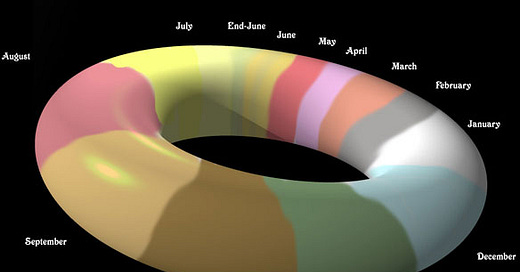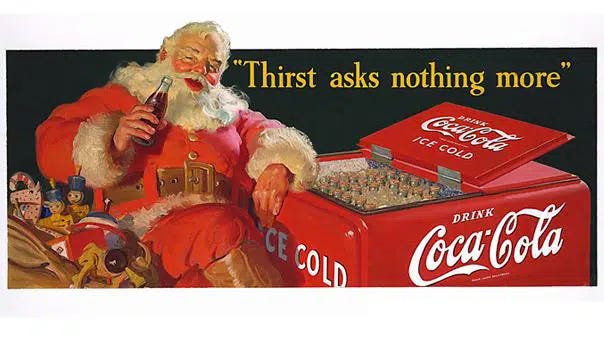Welcome back kiddos. As always, I’ve prepared a whirlwind of topics for you all that I’m hoping I can thread together so seamlessly you won’t realize that I partially edited this when I was violently high. Let’s begin.
There are a variety of ways people perceive the passing of time. For many, it was easily defined at a young age by the academic calendar. The first day of school marks the end of summer, which is the annual highlight, and therefore the “end” goal the year is working towards. But, as adults in the workforce, with no spectacular summer break to look forward to, time is defined by the changes in the world around us. While perhaps the seasons and the turn of fall used to define autumn, with the onset of perpetual summer looming over us, it can be bleak to rely only on the will of mother nature to provide us with an annual rhythm. Or if you’re just normal, you may think of time in the rudimentary way it’s explained to us, one calendar year turning into another on December 31st at 11:59 pm.
Spacial sequencing synesthesia refers to the unique way some individuals perceive the passage of time. From a study conducted by psychologist David Brang, everyone who had the time-space synesthesia pinpointed the same locations for months of the year on a blank chart in the same locations. Animated in the chart below, you can see that time moves for them in a circular motion, which is pretty quirky.
However, for everyone, the surroundings in our day-to-day life influence the way we view the world around us. For many people, special events are highlighted as starting or ending points, like birthdays or anniversaries. But what corporations are forcing is a perspective based on the holiday season. Today, November 3rd, Starbucks is releasing their annual winter holiday drink lineup, consisting of flavors like peppermint mocha, sugar cookie, and chestnut praline (all of which are pretty repulsing in my opinion). Regardless, the demand for these flavors and accessories approaches earlier and earlier in the calendar year each season. At Universal Studios, the first night of Halloween Horror Nights begins the first week of September, but I’ve seen Halloween decorations flooding department stores as early as my birthday (the first week of August). There shouldn’t be Spirit Halloweens popping up in abandoned shopping malls before children have even gone back to school. Can we at least use the autumn equinox as the turning point for celebrating fall? I don’t feel like that’s too much to ask.
And these changes are relatively new. Corporations stand to gain a lot, billions of dollars, by pushing up the arrival windows of new products and decorations, giving customers a longer window of opportunity to buy them and indulge in the nostalgic feelings they bring. The shopping experience has turned cyclical. There is no “control group” layout of a store anymore, no baseline shopping experience when you go to Target. Everything is commodified onto the calendar. As we speak, what little Thanksgiving decor is being swapped for dreidels and wreathes for the winter holidays (if they weren’t out already). It’s hard to conceive that even before Hanukkah and Christmas are over we’ll be seeing 2023 glitter sunglasses on every rack next to sparklers and marked up bottles of cheap champagne. Shortly after, comes the hearts and cards for Valentine's Day and so on. The only reprieve we have from the onslaught of BUY BUY BUY is the brief period in April following Easter, when the only holidays until Memorial Day are 4/20 and Earth Day. Best of luck to the marketing interns that have to figure out ways to up-sell t-shirts and I don’t know, eco-friendly bongs this spring without losing their loyal conservative fan base.
Valentine’s Day gets the worst reputation for being a holiday invented by corporations to sell cards and flowers; overall, it only generates the fourth most income annually compared to other holiday seasons. Even Labor Day, a holiday I recently learned is not also for the troops (which explains why every first Monday in September the phone call to my veteran grandfather always went a bit awkwardly), generates almost an additional ten billion more. If you visit amazon.com right now, there are Pre-Black Friday sales already happening. Black Friday is a designated day to shop in store for the holidays. There can’t be a virtual Pre-Black Friday. But by opening the window with so-called “discounts” (marking up prices of items to mark them down as 20% off) makes people feel like they need to make purchases they don’t. The psychology of sales boils down to companies manipulating us into making purchases we don’t need. It makes consumers feel like they’re saving money instead of spending. For example, there was a study done on vending machines where when one stand alone vending machine is in a public area, the question the consumer asks is “do I want a soda?”, but when two are placed alongside each other, the question becomes “which soda do I want?”.
Christmas by far is the most profitable holiday worldwide. In the United States alone, companies see roughly 700 billion dollars of profits annually. Even it’s modern depictions of Santa and the classic red and white color scheme originate from Coca Cola advertisements in the 1930s. Haddon Sundblom is an American artist who was commissioned to create new illustrations of Santa Claus matching the Coca Cola logo to generate profits and connect his image to their brand. So please reconsider that perhaps your obsession with the holiday season is an obsession with ads and capitalism, rather than what the holidays themselves stand for. I’d love to think that at its core, we can all reflect on the holiday season as a time of appreciation and friendship, but it statistically makes everyone more stressed and depressed with the anticipation of seeing family and the social responsibility to buy every acquaintance a gift.
This is all to say a few things:
Let’s put some effort into celebrating the lesser-known, sillier holidays we have. Not everything has to be about buying gifts. I’d love to see some people get really passionate about Groundhogs Day, because why not? When else do we get the obscure luxury of placing bets on a small rodent fleeing their burrow to see their shadow? I think that’s worth celebrating.
Cool it with the fireworks. They are a noise disturbance and a huge pollutant, it’s so obnoxious. And yes, this is targeted at my former employers Disney and Universal for having large-scale pyrotechnic displays across multiple properties on a daily basis. Is that not so obviously wasteful?
Consider alternative gift giving. I don’t want to see any box sets of lotions in excessive packaging or cheaply made peppermint scented candles this year. I’ve provided a list of potential ideas for that can be purchased at local businesses or homemade, because I love giving presents and most people suck at it:
Go to an antique store and buy the weirdest piece of home decor they have.
Buy the rights to a star (lifelong dream gift alert).
Make them a playlist and hire a high school band to perform it in public.
Pay for their therapy bill.
Make them a doomsday preparation bag. This shows you care about their wellbeing in the inevitable apocalypse and your taste preferences for canned goods and freeze-dried snacks (vital information on whether or not you’re truly compatible).
Name a Madagascar hissing cockroach after them at Bronx Zoo for $15.
Organize a flash mob but tell the other dancers not to show up. They will feel bad for you!
Go to a pottery class alone and post pictures to make them really jealous. A week later, when you pick up your artwork from the kiln, give it to them revealing you’ve engraved their name into a poorly made ceramic bowl.
Subscribe them to this blog without their knowledge! Fun way to keep people informed and let them know you have a really cool friend.
As always, thank you for reading, and see you next week!





